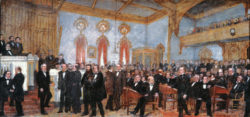Louisiana’s Secession from the Union
The election of Abraham Lincoln and threats to slavery’s expansion were two major factors in Louisiana’s decision to leave the Union.
This entry is 7th Grade level View Full Entry

Courtesy of the Louisiana State Museum
Signing the Ordinance of Secession of Louisiana. Perry, Jr., Enoch Wood (Artist)
How did Louisiana vote to secede from the Union?
On January 26, 1861, Louisiana seceded from the United States. Delegates to Louisiana’s secession convention meeting in Baton Rouge voted 113 to 17 to secede from the Union. The delegates lowered the American flag in the chamber and replaced it with a flag depicting a pelican feeding her young (the image on the state seal). Louisiana remained independent until March 21, 1861, when it joined the Confederate States of America.
The overwhelming pro-secession vote at the convention gives a false sense of antebellum Louisianans’ support for secession. Throughout the prewar period, Louisiana repeatedly rejected leaving the Union. During the 1832 Nullification Crisis, Louisiana did not support South Carolina “fire-eaters,” or secessionists. Former Louisiana Senator Edward Livingston even wrote Andrew Jackson’s Force Bill, which pledged military action against states who resisted federal law. Later, Louisiana supported the Compromise of 1850 and did not send a delegation to that year’s secessionist Nashville Convention. In addition, Louisiana’s Whigs did not support small government and state’s rights like other southern Whigs. Instead, they were closer to the northern branch of the party. They supported an activist nationalist government and wanted a sugarcane tariff and government aid for business.
Members of the 1861 secession convention included secessionists and cooperationists. The first group supported secession. The second group included unionists and those who wanted to meet with other southern states before seceding. Secessionists were in the majority. It is estimated that eighty delegates were secessionists, forty-four were cooperationists, and six were unknown, meaning it was not clear what they supported.
Why did Louisiana vote to secede from the Union?
White Louisianans shared other southerners’ commitment to slavery. They also opposed federal interference with the institution of slavery in the states or territories. As the Republican Party became dedicated to stopping slavery’s expansion, Louisianans became more open to leaving the United States. Two events pushed them toward secession. First, in October 1859, white abolitionist John Brown tried to start a slave rebellion. He raided Harpers Ferry, Virginia, for weapons, but the attempt failed, and he was hanged. This event scared white Louisianans who wanted to preserve slavery. Second, the result of the presidential election of 1860 was unpopular in Louisiana. Republican Abraham Lincoln won the election, but Louisiana had cast all its electoral votes for John C. Breckinridge, the candidate of the southern wing of the Democratic Party. Abraham Lincoln was not on the ballot in Louisiana and did not receive a single popular vote in the state.
Lincoln’s election changed views on secession in Louisiana. Three weeks before the election, a Democrat expressed Louisianans’ options if Lincoln won: “What are we to do? Shall we remain quiet and wait to see him inaugurated and develop his plan and policy or shall we anticipate what it will be and act at once to takes steps for our self-preservation? What shall these steps be? Shall we have a Southern Convention of the slave states or will each state act by itself? These are important questions.” For the next two months, Louisiana’s voters and political leaders struggled over the best answers to these questions.
Louisiana Governor Thomas Overton Moore and Senator John Slidell led the state’s secession movement publicly. Privately they maintained that they opposed immediate secession, but their public actions certainly pushed their fellow Louisianans away from the Union. In particular Governor Moore gave a pro-secession speech at the opening of the special December legislative session on January 7, 1861.
Other events contributed to the secessionist movement. A leading Presbyterian minister, Benjamin Palmer, delivered a sermon in New Orleans declaring God’s support for secession on Thanksgiving Day 1860, just weeks after Lincoln’s election. The speech went viral when newspapers across the South reprinted the sermon. More than fifty thousand copies were distributed.
What were the immediate results of Louisiana’s secession?
It was clear before the convention started that Louisiana would vote to secede. Governor Moore had already ordered Louisiana troops to take over the federal arsenal at Baton Rouge. He also ordered the takeover of two federal forts on the Mississippi River, Fort St. Philip and Fort Jackson. By the time Louisianans voted to secede in early January, South Carolina, Mississippi, Florida, Alabama, and Georgia had already seceded.
After the convention’s vote, the state prepared for war. Men volunteered to fight. Louisiana was worried about the possibility of having to fight against neighboring Texas, so they sent representatives to persuade Texas’s leaders to secede. They also seized the US Mint in New Orleans. The secession convention moved from Baton Rouge to New Orleans and sent six representatives to the convention in Alabama that formed the Confederate States of America. The secession convention ratified the Confederate Constitution on March 21 before adjourning on March 26.
